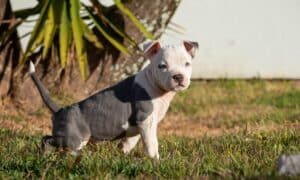“This post contains affiliate links, and I will be compensated if you make a purchase after clicking on my links.”
If you have an indoor dog, then you may need to learn how to prevent doggy spots on the lawn. Dogs and lawns don’t usually get along with each other. Even if their owners care for their pets properly, it still does not deny the fact that a dog peeing or eliminating in the green grass can ruin things. When your dog does this over time, the once perfectly green lawn can have, as what some people call it, “doggy spots”. These appear as either overgrown, dark grass in a certain spot, or as a circle spot of yellowing grass with dark overgrown grass surrounding the spot.
But according to University of California Extension’s environmental horticulture adviser, Ali Harivandi, it is possible for a dog to urinate and eliminate on the lawn, and have a nice, green, doggy spot-free lawn at the same time. Elimination is not a problem if you clean it up quickly, since it does not get absorbed quickly by the soil and the grass, unlike urine.
A dog’s urine is composed of salts and nitrogen, and usually in fairly strong concentrations. So when your dog pees, it affects that part of the lawn a lot like a plant fertilizer. According to Harivandi, nitrogen causes a strong growth spurt to the grass, which causes the overgrown “doggy spots” on your lawn. If you have a dog (or a neighbor’s dog) that regularly pees on your lawn, expect the grass to be uneven in height. Too much nitrogen can also kill or weaken the grass, as characterized by the yellowish grass that occurs at the spot if it is just left as is.
The amount of effect on the lawn depends on the dog’s size and gender; if a dog is small and/or only sprays to mark their territory, they may not cause significant damage unless left untreated. In contrast, bigger dogs, especially females ones, squat and relieve themselves. This makes the urine more concentrated, and larger dogs have a bigger volume of urine than small dogs.
How to Prevent Doggy Spots on the Lawn
Many spots can be reseeded in spring season or fall, and some will eventually disappear on their own. Species of grass that are slower to recover from doggy spots include perennial ryegrass and Kentucky bluegrass. Lawns with tall fescue, however, can recover from these doggy spots quickly.
The severity of the problems can vary with the season, especially this summer when the temperatures are hot, the grass is dry and there are drought conditions. This makes the effect of nitrogen on the grass more severe, and hinders the recovery of the doggy spots.
There are several ways to prevent doggy spots. There is only one “sure” way, according to Dr. Tony Koski, Extension Turf Specialist at Colorado State University, as he explains in the following article:
Train the dog to use an out-of-the-way area of the lawn where turf is not growing (an area mulched with gravel or mulch, for example) or where dog spotting will not become an aesthetic problem and damage can be tolerated. This is the ONLY sure solution for the problem!
Or if you live in an urban area, you may be able to train the dog to use the curb.
Giving your dog lots of water to drink also helps keep the nitrogen in the urine from being so concentrated. It also helps to pour water on the urine spot immediately to dilute the nitrogen. This is the next best method to the above.
There are also natural remedies that a dog can be fed, such as baking soda or methionine for neutralizing the urine. Baking soda can also be sprinkled on the spots. However, these are of limited usefulness.
These tips for how to prevent doggy spots on the lawn worked for me. The training took a while, since the dog was older, and the other methods kept the problem from getting out of hand until the training took over.
Is your dog “spotting” your lawn? Have you tries these tips yet?















Venus Factor
Aug 27, 2014 at 8:09 pm
Enable our cause. A buddie was just told they have
this. We should deliver our help and support!